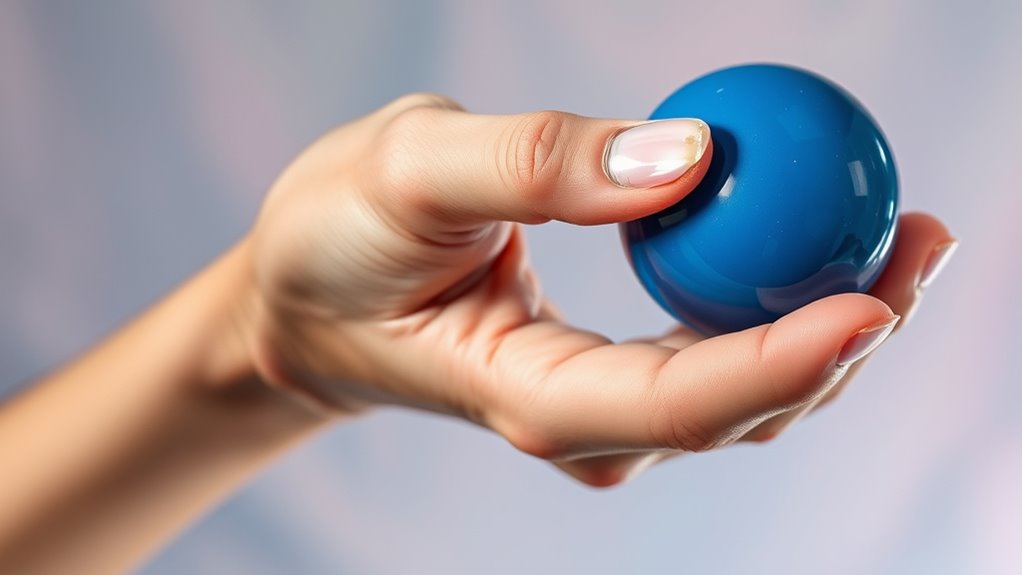Your favorite color can reveal a lot about your coping style. For example, choosing blue suggests you prefer calmness and stability when handling stress, while red indicates a proactive, assertive approach. Yellow reflects optimism and positivity, helping you bounce back from setbacks. Dark shades like black or gray might mean you’re introspective or cautious. By understanding these color cues, you can gain insight into how you manage life’s challenges, and there’s more to uncover if you keep exploring.
Key Takeaways
- Favorite colors reveal emotional states and stress management styles based on color psychology principles.
- Preference for calm colors like blue indicates a resilient, stability-seeking coping mechanism.
- Choosing passionate colors like red suggests an active, assertive approach to handling stress.
- Favoring optimistic colors such as yellow reflects a positive outlook and resilience through hope.
- Preference for dark shades like black or gray may signify introspective processing or cautious coping strategies.

Your favorite color can reveal more about your coping style than you might realize. Color psychology suggests that the hues you’re naturally drawn to reflect your emotional state and how you handle stress. When you choose a particular color repeatedly, it often indicates underlying traits related to emotional resilience and your approach to life’s challenges. For example, if you find yourself favoring calm, soothing shades like blue, it might suggest that you lean on serenity and stability to cope with adversity. Blue, associated with tranquility, can symbolize your desire to maintain inner peace during stressful times, indicating a resilient mindset that seeks calmness over chaos.
Alternatively, if your favorite color is red, it could reveal a more passionate, assertive coping style. Red often symbolizes energy, strength, and a readiness to confront problems head-on. People drawn to red tend to be more proactive in managing their stress, viewing challenges as opportunities for growth. Such individuals often demonstrate emotional resilience by channeling their intensity into action, rather than avoiding difficult emotions. They might prefer direct problem-solving strategies and are less likely to withdraw when faced with hardship.
Choosing colors like yellow could mean you’re optimistic and tend to use positive thinking as a way to cope. Yellow is associated with happiness, hope, and a sunny outlook, suggesting you may rely on a resilient mindset that emphasizes the bright side of situations. This attitude helps you bounce back from setbacks more easily, reinforcing your emotional resilience. Conversely, if you gravitate toward darker shades like black or gray, it might indicate a more introspective or cautious approach. These colors could reflect a tendency to process emotions internally or to seek solitude during tough times, which can be both a strength and a challenge in building resilience.
Your favorite color acts as a window into your emotional resilience, revealing how you handle stress and adversity. By understanding color psychology, you gain insight into your coping mechanisms, whether you lean toward calmness, assertiveness, optimism, or introspection. Recognizing these tendencies can help you develop more balanced strategies for managing emotional turmoil. If you notice a pattern in your color preferences, you might use that knowledge to strengthen your resilience—perhaps by intentionally incorporating colors that promote calmness or optimism into your environment. Ultimately, your favorite color is more than just a visual preference; it’s a reflection of your inner strength and how you navigate life’s ups and downs.
Frequently Asked Questions
Does Color Preference Change Over Time or With Mood Shifts?
You might notice that your color preferences change with your mood shifts or over time. Color psychology suggests that our choices reflect our emotional state, so during different periods, you may favor different shades. These shifts can be influenced by your experiences, environment, or feelings, making your favorite color a dynamic reflection of your current mood. It’s natural for your preferences to evolve as your mood shifts or as you grow.
Can Cultural Differences Influence Color Preferences and Coping Styles?
You might find that cultural symbolism plays a subtle role in shaping your color preferences, influencing how you perceive and respond to different shades. Cultural differences, rooted in shared experiences and beliefs, blend with color psychology to subtly guide your coping strategies. While your favorite colors may reflect personal tendencies, they are also intertwined with cultural nuances, reminding you that your reactions are often a beautiful mosaic of individual and collective meanings.
Are There Scientific Studies Supporting Color and Personality Links?
You might wonder if scientific studies support color psychology and how it relates to personality traits. Research shows that certain colors can influence mood and behaviors, suggesting links between color preferences and personality. For example, blue often correlates with calmness, while red relates to energy. While these studies provide insights, individual differences mean color psychology isn’t a perfect predictor, but it can offer clues about personality traits.
How Accurate Is Color-Based Personality Prediction Generally?
Color psychology offers some insights into personality traits, but it’s not highly accurate for predicting your overall personality. Your favorite color may reflect certain tendencies, but many factors shape your personality beyond color preferences. So, while color psychology can provide interesting clues, don’t rely solely on it for understanding yourself or others. It’s best to take into account it as just one tiny piece of a much larger puzzle.
Can Multiple Favorite Colors Indicate Mixed Coping Strategies?
Did you know that 65% of people have multiple favorite colors? Your color choice can reflect diverse coping mechanisms, as emotional associations from color psychology suggest. If you like several colors, it might indicate you’re using mixed coping strategies—sometimes seeking comfort, other times motivation. Recognizing this can help you understand your emotional responses better, and tailor your coping mechanisms to fit your needs more effectively.
Conclusion
So, next time you pick your favorite color, remember it might reveal more about your coping style than you think. Your color choice isn’t just a simple preference—it’s like a secret code to your inner world. Don’t underestimate the power of your favorite hue; it could be the key to understanding yourself better than a thousand therapy sessions. Your color isn’t just beautiful—it’s a window into your soul’s most hidden coping strategies.
Felicity, our Author, pens in-depth articles and guides that delve into the heart of personal discovery. Her narrative-driven approach weaves together theory, practice, and personal anecdotes, making the journey of self-exploration both relatable and inspiring. Felicity’s contributions help illuminate the path for those seeking a deeper understanding of themselves and their relationships.










